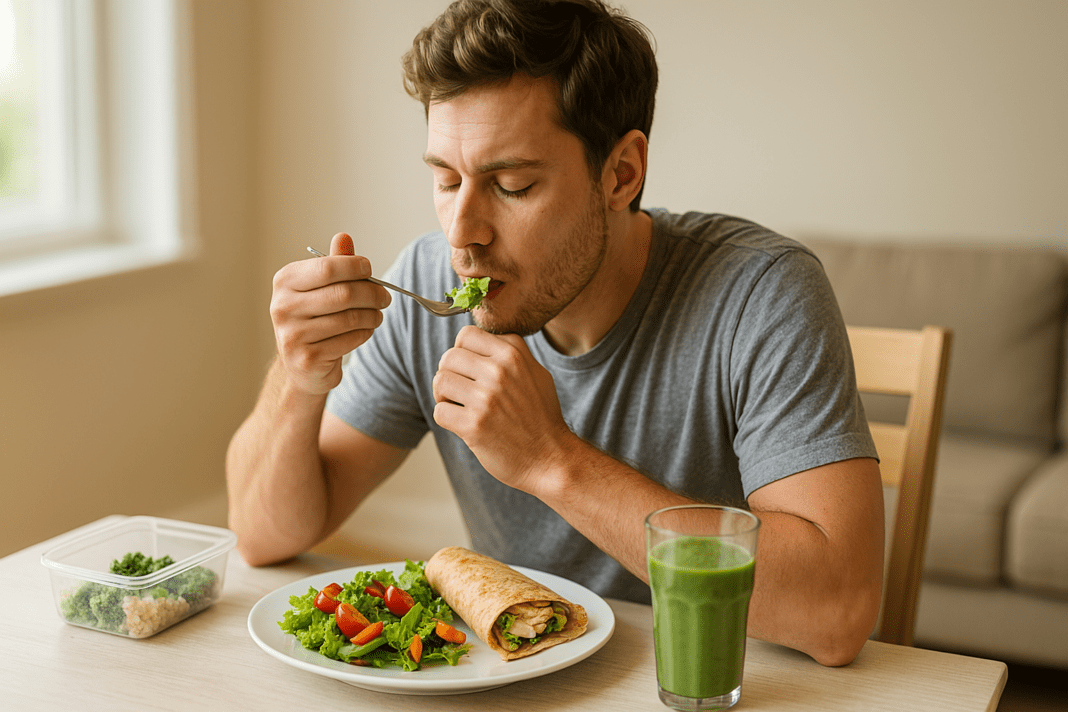In a world where time is often the most limited resource, many people find themselves compromising on nutrition. Busy schedules, long commutes, and erratic work hours frequently push individuals toward convenient but less-than-healthy food options. Yet, with a little strategy and mindfulness, it’s entirely possible to maintain a nutritious diet even when relying on fast food or grabbing a meal late at night. The demand for healthy lunch ideas fast food style and healthy late night fast food options is steadily increasing, reflecting a growing awareness that convenience and health do not have to be mutually exclusive. This article explores practical, evidence-informed strategies for making smart food choices without sacrificing nutritional value, especially when time is short and fast food seems like the only viable option.
You may also like: Smart Healthy Eating Tips for Busy Professionals: How to Stay Nourished When You’re Always on the Go
Rethinking Fast Food: A Nutritional Perspective
The term “fast food” often conjures images of greasy burgers, fried items, and sugary sodas. However, the fast food landscape has evolved significantly over the past decade. Many major chains have responded to consumer demand by introducing healthier menu items. Grilled proteins, fresh salads, fruit options, and whole grain choices are now more accessible than ever. What matters most is how we approach the fast food experience. Understanding menu labeling, portion sizes, and how to balance macronutrients can transform a seemingly unhealthy meal into one that supports energy and wellness.
Healthy lunch ideas fast food enthusiasts should consider include ordering grilled chicken sandwiches without mayonnaise, choosing side salads over fries, or opting for whole wheat wraps. Adding a piece of fruit or a side of vegetables can enhance the nutritional profile of these meals significantly. Additionally, being aware of sodium content is critical, as many fast food items are high in salt, which can contribute to elevated blood pressure when consumed excessively. Choosing water or unsweetened iced tea instead of sugary beverages also helps maintain hydration without added calories.

Balancing Macronutrients on the Go
Nutrition experts often emphasize the importance of balancing macronutrients—proteins, carbohydrates, and fats—in every meal. For individuals relying on fast food, this means seeking out meals that include lean proteins, complex carbohydrates, and healthy fats. Protein helps sustain energy and supports muscle maintenance, while complex carbs such as brown rice or whole grain bread provide lasting satiety. Healthy fats, found in sources like avocado or nuts, contribute to hormonal balance and brain health.
When exploring healthy lunch ideas fast food options, it’s wise to select menu items that combine these components. A burrito bowl with brown rice, black beans, grilled chicken, and vegetables can be a balanced and satisfying choice. Including guacamole adds healthy fats, while a scoop of salsa offers flavor without excess calories. Similarly, many fast-casual restaurants allow diners to customize their meals, offering a chance to build a nutritionally sound plate even when time is tight.
The Science Behind Late-Night Eating
Late-night eating often carries a negative connotation, largely due to its association with weight gain and disrupted digestion. However, recent research reveals that the timing of meals is not as detrimental as once believed, provided the quality of food remains high. The human body is designed to digest food around the clock, although certain physiological processes, such as insulin sensitivity, do decrease at night. This means that heavy, high-sugar meals may be harder to process late in the evening.
Nevertheless, healthy late night fast food choices can still support metabolic health. Foods that are lower in refined carbs and higher in protein and fiber tend to be better tolerated. Grilled chicken, vegetables, whole grain wraps, and light soups are all viable options. Avoiding fried foods, creamy sauces, and sugary treats is key to preventing digestive discomfort and ensuring restful sleep. Ultimately, the focus should be on nutrient density and portion control, rather than rigid meal timing.
Navigating Drive-Thru Menus with Confidence
One of the most practical skills for busy professionals is learning how to decode fast food menus quickly and efficiently. With a little preparation, it becomes easier to identify healthy lunch ideas fast food style and make choices that align with personal wellness goals. Start by scanning for grilled proteins rather than fried ones, and look for meals labeled as “light” or “under 500 calories.” Many restaurants now provide full nutritional information online or on their mobile apps, offering a chance to plan ahead.
Swapping out fries for apple slices, yogurt, or a side salad is a simple yet powerful move. Reducing portion size by ordering a smaller sandwich or choosing a kid’s meal can also help regulate calorie intake without feeling deprived. Even within the fast food sphere, many establishments offer plant-based options that are lower in saturated fat and calories. These alternatives, while not always perfect, can still contribute to a more balanced diet when selected mindfully.
The Role of Hydration and Smart Beverage Choices
In the rush to grab a meal, beverages are often an afterthought. However, what you drink can significantly influence the overall healthfulness of your meal. Sugary sodas, energy drinks, and sweetened teas add empty calories and can lead to energy crashes. On the other hand, choosing water, sparkling water, or herbal teas supports hydration and avoids unnecessary sugar intake.
For those seeking healthy late night fast food or a nutritious lunch on the go, prioritizing beverages that support digestion and hydration is key. Some restaurants offer low-calorie options like unsweetened iced tea or flavored water. These choices not only complement your meal but also help regulate appetite and maintain energy levels throughout the day. Establishing a habit of making smart beverage selections is a simple yet impactful way to enhance your overall nutrition.
Meal Timing, Metabolism, and Realistic Flexibility
While much has been written about the ideal timing of meals, the reality is that flexibility often trumps perfection. Life doesn’t always allow for breakfast at 8:00 a.m., lunch at noon, and dinner at 6:00 p.m. For many, irregular work hours and social commitments mean that meals happen when they can. Fortunately, research suggests that what you eat matters more than when you eat it. Nutrient-dense meals can support metabolic health at any time of day.
Healthy late night fast food options become especially important for shift workers, students, and anyone who keeps unusual hours. Prioritizing quality ingredients, balanced macronutrients, and reasonable portions can help mitigate the downsides of eating at night. Similarly, embracing healthy lunch ideas fast food style means acknowledging that flexibility is part of modern life, and learning how to work within that framework rather than fight against it.

Creating a Sustainable Healthy Eating Routine
The key to long-term success with nutrition lies in sustainability. Rigid rules and unrealistic expectations often lead to burnout or rebellion. Instead, building a flexible framework that includes room for fast food, late-night snacks, and unexpected schedule changes is more likely to yield lasting results. This requires planning ahead when possible, but also cultivating the ability to make smart choices in the moment.
Healthy lunch ideas fast food and mindful selections for late-night meals are not just quick fixes; they are integral parts of a broader lifestyle strategy. By emphasizing whole foods, balanced nutrients, and mindful eating, individuals can maintain their health even when life gets hectic. Over time, these choices become second nature, creating a positive feedback loop that reinforces good habits and supports well-being.
Frequently Asked Questions (FAQ)
What are some overlooked options for healthy late night fast food that don’t disrupt sleep?
While most people think of grilled chicken salads or veggie wraps as standard healthy late night fast food options, there are several lesser-known choices that can satisfy hunger without disrupting sleep. For example, a small serving of oatmeal with almond butter from all-night cafes can provide tryptophan and magnesium, both known to support better rest. Some Mediterranean fast-casual restaurants offer lentil soup and hummus plates, which are light yet filling and easier to digest late in the day. Even a baked potato with minimal toppings can be comforting without overwhelming your digestive system. Ultimately, keeping meals low in sugar and saturated fat is key for late-night consumption.
Can healthy lunch ideas fast food style still offer enough energy for physically active professionals?
Yes, when planned properly, fast food meals can absolutely provide sufficient fuel for those with active lifestyles. Look for high-protein options like grilled steak wraps, turkey sandwiches, or rice bowls with tofu. Pairing these with fiber-rich vegetables and whole grains creates a complete, energizing meal. It’s important to be intentional about meal timing, especially around workouts, to ensure sustained energy and recovery. Healthy lunch ideas fast food choices that incorporate balanced macronutrients and minimal added sugars are ideal for professionals who move often or work physically demanding jobs.
What are the social and psychological benefits of allowing healthy late night fast food into a routine?
Including healthy late night fast food options in your routine can reduce food anxiety and eliminate guilt often associated with “breaking the rules” of strict eating schedules. From a psychological standpoint, giving yourself permission to eat when hungry—even late at night—supports a positive relationship with food. Socially, being flexible with food timing allows you to engage more comfortably in late-night work sessions, travel schedules, or social events without compromising your wellness. Eating balanced, satisfying meals at any hour can contribute to better emotional regulation and reduce the stress associated with rigid dietary expectations. Ultimately, adaptability supports consistency in healthy habits.
Are there innovative packaging trends that support healthier fast food consumption on the go?
Yes, the fast food industry has made strides in sustainable and functional packaging that encourages better eating habits. Bento-style boxes and compartmentalized containers now help keep ingredients like greens, grains, and proteins fresh and separate until consumption. These containers support portion control and can be repurposed for future meals. Some fast food chains now use transparent labeling directly on packaging to display calorie counts and macronutrient breakdowns, making healthy lunch ideas fast food more accessible and data-driven. This transparency empowers customers to make more informed decisions, especially when time is limited.
How can professionals use meal timing to optimize healthy fast food choices throughout a long workday?
Strategic meal timing can enhance the effectiveness of healthy lunch ideas fast food by matching nutrient intake with natural energy dips and cognitive demand. For example, eating a balanced lunch between 12:00 and 1:30 p.m. can help prevent the typical mid-afternoon slump. Including a small protein-rich snack around 3:30 or 4:00 p.m. can stabilize blood sugar and prevent overeating at dinner. For night-shift workers or those who work late, consuming healthy late night fast food options like a lean protein wrap or miso soup can promote energy without overstimulation. Planning your intake according to work rhythms, rather than arbitrary rules, leads to better energy balance.
Is it possible to meal-prep using healthy late night fast food as inspiration?
Absolutely. Many people now model their weekly meal prep after their favorite healthy late night fast food items. For instance, a grilled chicken pita with hummus and greens can easily be recreated at home in bulk. Preparing oven-roasted sweet potatoes, cooked lentils, and rotisserie chicken ahead of time can form the base of several nutrient-rich bowls or wraps. These DIY versions offer more control over sodium and oil content while still mimicking the fast food convenience and taste. Taking inspiration from these meals also prevents flavor fatigue and encourages variety.
How can parents or caregivers use fast food culture to teach children about nutrition?
Instead of framing fast food as “bad,” caregivers can use the setting to educate children on making smart food choices. When presented with healthy lunch ideas fast food menus, children can learn to spot protein-rich items or whole grain sides. Turning it into a game—such as finding the vegetable with the most fiber—makes the experience interactive. Caregivers can also demonstrate balance by pairing a favorite treat with a more nutrient-dense item. This approach instills critical thinking around food rather than fear or shame.
Are there cultural or regional influences on what constitutes healthy fast food?
Definitely. In Japan, for example, convenience stores offer seaweed-wrapped rice balls, miso soup, and boiled eggs as quick, healthy options. In the Mediterranean region, fast food often includes falafel, fresh salads, and grilled meats. These options contrast heavily with the Western emphasis on burgers and fries. Understanding how healthy lunch ideas fast food vary by culture broadens one’s perspective and allows for more diverse and enjoyable eating experiences. It also highlights how cultural norms can drive demand for better fast food alternatives globally.
What role does digital technology play in supporting healthy fast food choices?
Mobile ordering apps now allow users to customize meals in real time, filter menu items by dietary needs, and track nutrient intake. Some platforms even make personalized suggestions based on previous orders or fitness goals. For those seeking healthy late night fast food, geo-located apps can identify nearby 24-hour restaurants with lighter options. Integration with fitness trackers can also help align meal choices with physical activity levels. These tools promote empowerment and reduce the cognitive load of decision-making in fast-paced environments.
How can someone recovering from disordered eating approach fast food in a healthy way?
For individuals healing from disordered eating, reintroducing fast food mindfully can be part of a balanced recovery. It’s crucial to approach these meals without judgment and to tune in to internal cues of hunger and fullness. Practicing self-compassion and allowing room for healthy late night fast food or lunch options can help dismantle all-or-nothing thinking around nutrition. Working with a dietitian can provide personalized strategies for reintegrating these foods in a way that supports both physical and emotional health. Over time, the goal is to make peace with all foods, including those that are convenient and enjoyable.

Final Thoughts on Smart Eating: Making Healthy Fast Food Work for You
Maintaining a nutritious diet in today’s fast-paced world doesn’t require perfection, but it does require intentionality. With the right mindset and knowledge, healthy lunch ideas fast food style and healthy late night fast food choices can become valuable tools rather than nutritional compromises. By focusing on balance, portion control, and mindful eating, even the busiest individuals can prioritize their health without sacrificing convenience.
The goal is not to eliminate fast food or late-night meals, but to reframe how we approach them. Choosing grilled over fried, opting for water over soda, and building meals around lean proteins and vegetables are all practical steps anyone can take. With a bit of preparation and awareness, it is entirely possible to enjoy fast food without undermining your nutritional goals. Ultimately, smart eating is about making the best possible choice in each moment, supported by a foundation of knowledge, experience, and self-care.
nutritious fast food options, balanced meals on the go, smart eating habits, mindful meal planning, healthy takeout choices, clean eating lifestyle, quick nutritious meals, eating well while busy, fast casual nutrition tips, wellness-focused food choices, practical nutrition strategies, staying healthy with a busy schedule, protein-rich fast food, low-calorie meal options, smart food swaps, late night snack ideas, digestive-friendly meals, portion control tips, sustainable healthy eating, nutrition for professionals
Further Reading:
11 Simple Ways to Adopt a Balanced, Sustainable Eating Pattern
15 Time-Saving Tips For Eating Healthy When You’re Busy
Healthy Eating for Busy Lifestyles
Disclaimer
The information contained in this article is provided for general informational purposes only and is not intended to serve as medical, legal, or professional advice. While NewsHealthWatch strives to present accurate, up-to-date, and reliable content, no warranty or guarantee, expressed or implied, is made regarding the completeness, accuracy, or adequacy of the information provided. Readers are strongly advised to seek the guidance of a qualified healthcare provider or other relevant professionals before acting on any information contained in this article. NewsHealthWatch, its authors, editors, and contributors expressly disclaim any liability for any damages, losses, or consequences arising directly or indirectly from the use, interpretation, or reliance on any information presented herein. The views and opinions expressed in this article are those of the author(s) and do not necessarily reflect the official policies or positions of NewsHealthWatch.

